 Yamaha Tracer MT09TRA - Service manual > Fuel injection system
Yamaha Tracer MT09TRA - Service manual > Fuel injection system
Circuit diagram

3. Main switch
4. Main fuse
7. Electric throttle valve fuse
8. Backup fuse
11.Ignition fuse
15.Battery
16.Engine ground
17.Fuel injection system fuse
18.Starter relay
20.Joint connector
21.Joint coupler
22.Relay unit
23.Starting circuit cut-off relay
24.Fuel pump relay
25.Sidestand switch
26.Immobilizer unit
27.ECU (engine control unit)
28.Ignition coil #1
29.Ignition coil #2
30.Ignition coil #3
31.Spark plug
32.Injector #1
33.Injector #2
34.Injector #3
37.Air induction system solenoid
38.O2 sensor
39.Crankshaft position sensor
40.Intake air temperature sensor
41.Coolant temperature sensor
42.Intake air pressure sensor 1
43.Intake air pressure sensor 2
44.Lean angle sensor
46.Rear wheel sensor
47.ABS ECU (electronic control unit)
48.Throttle servo motor
49.Accelerator position sensor
50.Throttle position sensor
51.Yamaha diagnostic tool coupler
52.Meter assembly
57.Multi-function meter
59.Engine trouble warning light
66.Gear position switch
68.Fuel pump
69.Handlebar switch (right)
70.Drive mode switch
71.Start/engine stop switch
76.Handlebar switch (left)
77.Clutch switch
88.Headlight control unit
95.Radiator fan motor relay
Ecu self-diagnostic function
The ECU is equipped with a self-diagnostic function in order to ensure that the fuel injection system is operating normally. If this function detects a malfunction in the system, it immediately operates the engine under substitute characteristics and illuminates the engine trouble warning light to alert the rider that a malfunction has occurred in the system. Once a malfunction has been detected, a fault code number is stored in the memory of the ECU.
- To inform the rider that the fuel injection system is not functioning, the engine trouble warning light flashes while the " " side of the start/engine stop switch is being pushed to start the engine.
- If a malfunction is detected in the system by the self-diagnostic function, the ECU provides an appropriate substitute characteristic operation, and alerts the rider of the detected malfunction by illuminating the engine trouble warning light.
- After the engine has been stopped, the lowest fault code number appears on the meter display. Once a fault code has been displayed, it remains stored in the memory of the ECU until it is deleted.
Engine trouble warning light indication and fuel injection system operation

*The warning light flashes when any one of the following conditions is present and the " " side of the start/engine stop switch is pushed:
12: Crankshaft position sensor
19: Sidestand switch (open circuit in the wire to the ECU)
30: Lean angle sensor (latch up detected)
41: Lean angle sensor (open or short circuit)
50: ECU internal malfunction (faulty ECU memory)
Checking the engine trouble warning light
The engine trouble warning light comes on for around 2 seconds after the main
switch has been set to "ON" and it comes on while the " " side of the
start/engine stop switch is being pushed. If the warning light does not come on
under these conditions, the warning light (LED) may be defective.

a. Main switch "OFF"
b. Main switch "ON"
c. Engine trouble warning light off
d. Engine trouble warning light on for around 2 seconds
ECU detects an abnormal signal from a sensor
If the ECU detects an abnormal signal from a sensor while the vehicle is being driven, the ECU illuminates the engine trouble warning light and provides the engine with alternate operating instructions that are appropriate for the type of malfunction.
When an abnormal signal is received from a sensor, the ECU processes the specified values that are programmed for each sensor in order to provide the engine with alternate operating instructions that enable the engine to continue operating or stop operating, depending on the conditions.
Troubleshooting method
The engine operation is not normal and the engine trouble warning light comes on.
1. Check:
- Fault code number
a. Check the fault code number displayed on the meter.
b. Identify the faulty system with the fault code number.
c. Identify the probable cause of the malfunction.
2. Check and repair the probable cause of the malfunction.

3. Perform the reinstatement action for the fuel injection system.
Refer to "Confirmation of service completion" in the appropriate table in "TROUBLESHOOTING DETAILS" on page 8-38.
4. Set the main switch to "OFF", then to "ON" again, and then check that no fault code number is displayed.
TIP
If another fault code number is displayed, repeat steps (1) to (4) until no fault code number is displayed.
5. Erase the malfunction history in the diagnostic mode (code No.62).
TIP
Setting the main switch to "OFF" will not erase the malfunction history.
The engine operation is not normal, but the engine trouble warning light does not come on.
1. Check the operation of the following sensors and actuators in the
diagnostic mode.

If a malfunction is detected in the sensors or actuators, repair or replace all faulty parts.
If no malfunction is detected in the sensors and actuators, check and repair the inner parts of the engine.
Diagnostic mode
Setting the diagnostic mode
1. Turn the main switch to "OFF".
2. Disconnect the wire harness coupler from the fuel pump.
3. Simultaneously press and hold the "TCS" button "1" and "RESET" button "2", turn the main switch to "ON", and continue to press the buttons for 8 seconds or more.
TIP
"ECU" appears on the multi-function meter right display.
4. Simultaneously press the "TCS" button and "RESET" button for 2 seconds or more.

5. While "DIAG" is displayed on the multi-function meter right display, simultaneously press the "TCS" button "1" and "RESET" button "2" for 2 seconds or more.
TIP
Press the "TCS" button to switch the display between "DIAG" and "CO".

6. Select the diagnostic code number corresponding to the fault code number by pressing the "TCS" button or "RESET" button.
TIP
- To decrease the selected diagnostic code number, press the "RESET" button. Press the "RESET" button for 1 second or more to automatically decrease the diagnostic code numbers.
- To increase the selected diagnostic code number, press the "TCS" button. Press the "TCS" button for 1 second or more to automatically increase the diagnostic code numbers.

a. Diagnostic code number increases.
b. Diagnostic code number decreases.
7. Check the operation of the sensor or actuator.
- Sensor operation
The data representing the operating conditions of the sensor appears on the multi-function meter right display.
- Actuator operation
To operate the actuator, set the start/engine stop switch from "
 " to "
" to "
 ".
".
Turn the main switch to "OFF" to cancel the diagnostic mode.
TIP
Information about each diagnostic code number is organized in this manual as follows:
- If a diagnostic code number has a corresponding fault code number, the information is shown in "TROUBLESHOOTING DETAILS".
- If a diagnostic code number does not have a corresponding fault code number, the information is shown in "DIAGNOSTIC CODE TABLE".
9. Connect the wire harness coupler to the fuel pump.
Yamaha diagnostic tool
This model uses the Yamaha diagnostic tool to identify malfunctions.
For information about using the Yamaha diagnostic tool, refer to the operation manual that is included with the tool.
 Yamaha diagnostic tool 90890-03231
Yamaha diagnostic tool 90890-03231
Features of the Yamaha diagnostic tool
You can use the Yamaha diagnostic tool to identify malfunctions quicker than with conventionalmethods.
By connecting the adapter interface, which is connected to the USB port of a computer, to a vehicle's ECU using the communication cable, you can display information that is necessary for identifying malfunctions and for maintenance to display on the computer. The displayed information includes the sensor output data and information recorded in the ECU.
Functions of the Yamaha diagnostic tool
Fault diagnosis mode:
- Fault codes recorded on the ECU are read, and the contents are
displayed.
The freeze frame data (FFD) is the operation data when a malfunction was detected. This data can be used to identify when the malfunction occurred and check the engine conditions and running conditions when it occurred.
Function diagnostic mode:
- Check the operation of the output value of each sensor and actuator.
Inspection mode:
- Determine whether each sensor or actuator is functioning properly.
CO adjustment mode:
- Adjust the concentration of CO admissions during idling.
Monitoring mode:
- Displays a graph of sensor output values for actual operating conditions.
Logging mode:
- Records and saves the sensor output value in actual driving conditions.
View log:
- Displays the logging data.
ECU rewrite:
- If necessary, the ECU is rewritten using ECU rewrite data provided by
Yamaha.
Ignition timing adjustment, etc. cannot be changed from the vehicle's original state.
However, the diagnostic tool cannot be used to freely change the basic vehicle functions, such as adjusting the ignition timing.
Connecting the Yamaha diagnostic tool
Remove the protective cap "1", and then connect the Yamaha diagnostic tool "2" to the coupler.

TIP
When the Yamaha diagnostic tool is connected to the vehicle, the operation of the multi-function meter and indicators will be different from the normal operation.
Troubleshooting details
This section describes the measures per fault code number displayed on the meter. Check and service the items or components that are the probable cause of the malfunction following the order given.
After the check and service of the malfunctioning part have been completed, reset the meter display according to the reinstatement method.
Fault code No.: Fault code number displayed on the meter when the engine failed to work normally.
Diagnostic code No.: Diagnostic code number to be used when the diagnostic mode is operated.
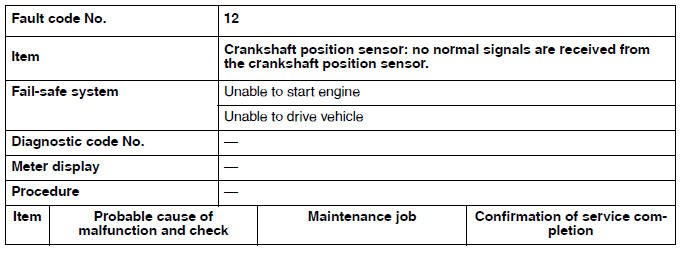
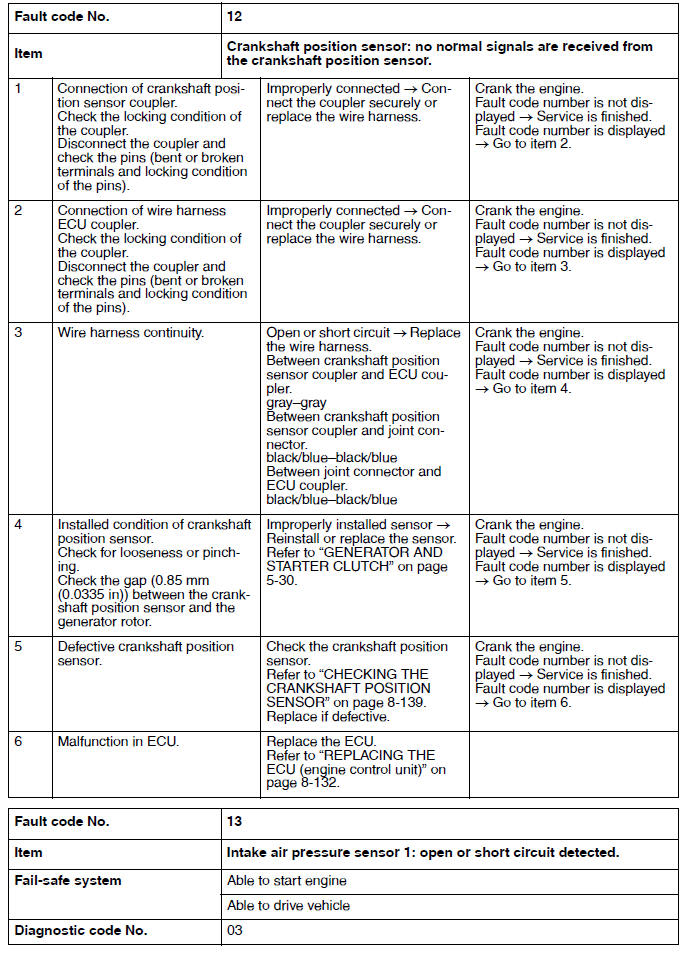


TIP
If fault code numbers "13" and "14" are both indicated, take the actions specified for fault code number "13" first.










TIP
- If fault code numbers "25" and "26" are both indicated, take the actions specified for fault code number "25" first.
- If fault code numbers "25" and "14" are both indicated, take the actions specified for fault code number "25" first.
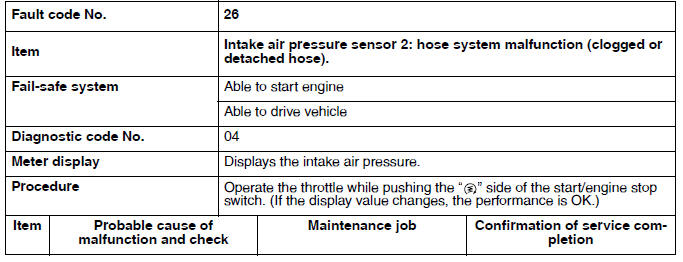

TIP
- If fault code numbers "25" and "26" are both indicated, take the actions specified for fault code number "25" first.
- If fault code numbers "26" and "37" are both indicated, take the actions specified for fault code number "26" first.
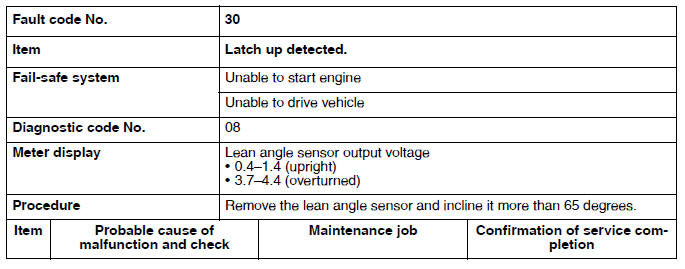




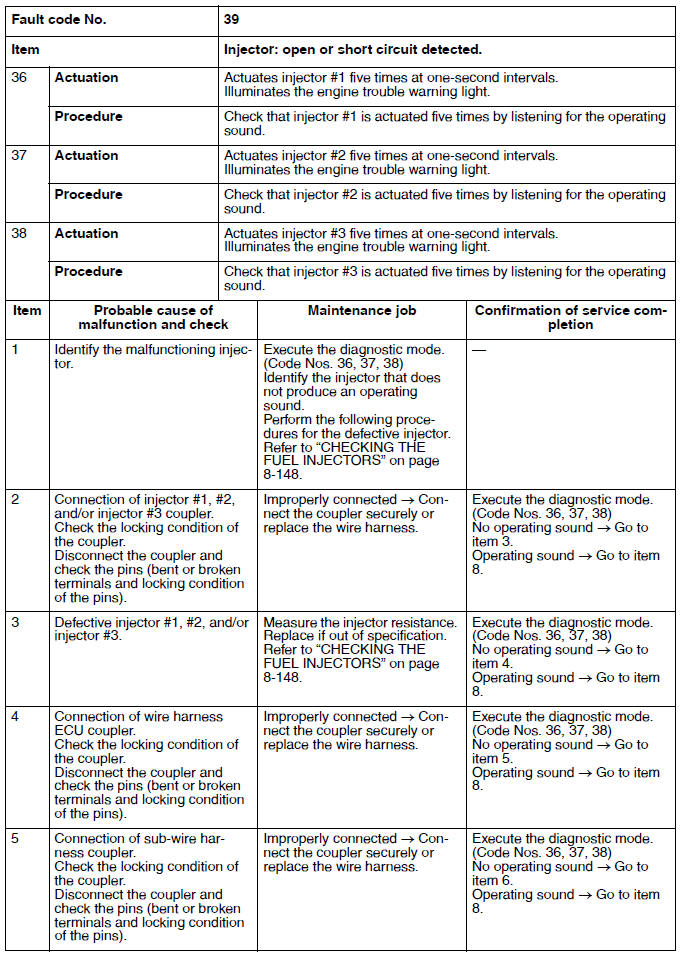





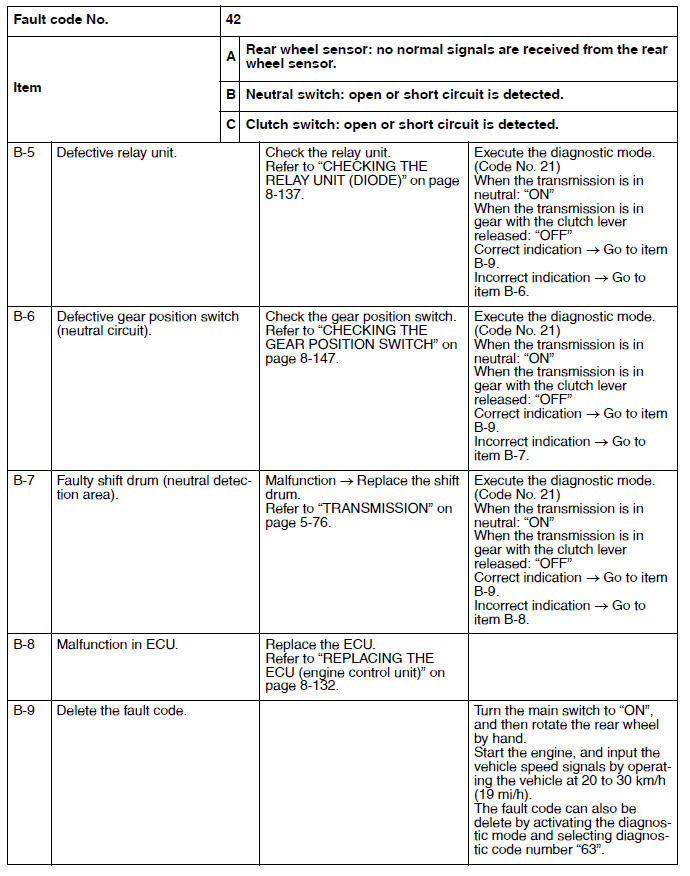




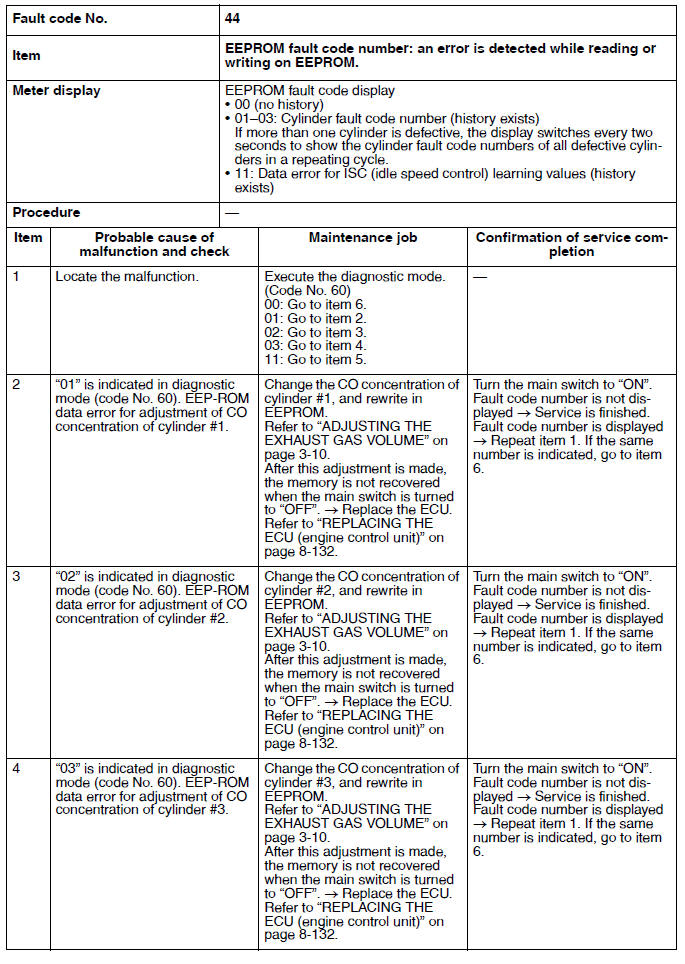







See also:
 Yamaha Tracer MT09TRA - Service manual > Signaling system
Yamaha Tracer MT09TRA - Service manual > Signaling system
Circuit diagram 3. Main switch 4. Main fuse 11.Ignition fuse
 Yamaha Tracer MT09TRA - Service manual > Fuel pump system
Yamaha Tracer MT09TRA - Service manual > Fuel pump system
Circuit diagram 3. Main switch 4. Main fuse 11.Ignition fuse

 BMW G310GS
BMW G310GS Honda CBR125RW
Honda CBR125RW Husqvarna 401 Vitpilen
Husqvarna 401 Vitpilen KTM 890 Duke R
KTM 890 Duke R Mash Dirt Track 650
Mash Dirt Track 650 Peugeot Kisbee
Peugeot Kisbee Yamaha Tracer MT-09
Yamaha Tracer MT-09 Honda CBR125RW
Honda CBR125RW Peugeot Kisbee
Peugeot Kisbee Yamaha Tracer MT-09
Yamaha Tracer MT-09